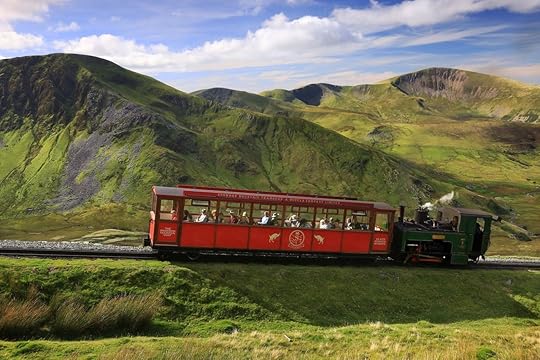Matador Network's Blog, page 626
July 19, 2021
Mexico is raffling off one of El Chapo’s safe houses for $12.50

Ever wanted to see what it was like to live in an expansive, real-world cartel mansion like the ones on Narcos? Well, here is your chance: The Mexican government is raffling off one of the houses of infamous drug lord Joaquín “El Chapo” Guzmán.
A raffle ticket and chance to win only costs 250 Mexican pesos (about $12.50). The two-bedroom house is in northwestern Mexico and was once used as a hideout. In 2014, Guzmán escaped capture by going through a fake bathtub to a system of secret tunnels.
This isn’t even the only property being raffled off. The government is also offering prizes like the mansion that belonged to former Juárez cartel leader Amado Carrillo in the El Pedregal region of Mexico City.

Photo: Government of Mexico
The raffle is run by a government branch, called the Institute to Give Back to the People the Stolen (INDEP). These “prizes” are confiscated items from criminals, drug members, gangs, etc., that the Mexican government now owns. INDEP runs public auctions that sell these items that were seized.
El Chapo’s two-bedroom house will be awarded in the same condition that it was left in as with all other properties. The winner of the raffle will be announced on September 15, the day before Mexican Independence Day.
There’s just one catch, according to the Australian site Monster Children: Foreigners can’t own the assets raffled off by INDEP (it’s giving back to the local people, not just people in general). Those who would like to enter the raffle can do so online. 
The post Mexico is raffling off one of El Chapo’s safe houses for $12.50 appeared first on Matador Network.
7 repurposed Olympic sites that are still worth visiting today

Delayed multiple times, the long-awaited Tokyo Olympics are finally set to take place at the end of July, but without any crowds in attendance. It sounds anticlimactic, especially after the yearlong wait. We can’t see the architecture and the work that Tokyo put in as the host city in person this year. Still, there’s always a chance the infrastructure will survive and take on a new life and purpose after the games.
While it’s true that some Olympic sites are abandoned after they serve their purpose, there are beautiful Olympic villages from years gone by you can still visit. There are also sites that’ve been creatively repurposed as urban renewal projects, athletic arenas, waterparks, and other venues that benefit the community. From China’s largest waterpark to a concert venue in Australia, these are the repurposed Olympic sites you can (and should) see in person.
1. Queen Elizabeth Olympic Park — London, England
Photo: PJ_Photography/Shutterstock
London hosted the summer Olympics in 2012 and built many of its Olympic venues in the East End neighborhood with the aim of sparking urban renewal. Queen Elizabeth Olympic Park initially contained the Olympic stadium, swimming pool, athletes’ villages, and other Olympic sporting venues. After the games, it was renamed in honor of Queen Elizabeth II’s diamond Jubilee. It’s now home to parklands, waterways, playgrounds, and sport venues, including London Stadium, the London Aquatics Centre, the Copper Box Arena, and Lee Valley VeloPark.
2. Happy Magic Water Cube — Beijing, China
Photo: fotohunter/Shutterstock
The Water Cube was one of the most recognizable buildings from the 2008 summer Olympics in Beijing. It served as a water sports venue and is where Michael Phelps won eight gold medals. After the Olympics ended, the space certainly didn’t go to waste. It was converted into China’s largest indoor water park, and dubbed the Happy Magic Water Cube. With a capacity of 6,000 people, the park is famous for its giant Wave Pool and AquaTube Body Slides. Not only has the Olympic venue been successfully repurposed, it also quickly became the second most popular tourist destination in Beijing after the Great Wall of China.
3. Centennial Olympic Park — Atlanta, Georgia, USA
Photo: ESB Professional/Shutterstock
Investments for the 1996 Summer Olympics helped Atlanta transform its downtown area. Centennial Olympic Park played a major role in that revitalization. Today, the park is a tourist draw that includes the College Football Hall of Fame, National Center for Civil & Human Rights, World of Coca-Cola, Georgia Aquarium, CNN Center, and Children’s Museum of Atlanta. A nod to Atlanta’s Olympic history can be seen at the park’s Fountain of Rings, which is the world’s largest interactive fountain.
4. Sydney Showground — Sydney, Australia
Photo: Chayut Orapinpatipat/Shutterstock
Built for Sydney’s 2000 Summer Olympics, the Sydney Olympic Park replaced a run-down industrial park. After the Olympics the 1,580-acre park was transformed into the Sydney Showground, repurposed to house exhibitions, events, and concerts. The showground attracts over 12 million annual visitors — particularly for the Sydney Royal Easter Show each year — and the Dome, which used to host Olympic basketball games, remains an indoor sporting venue and the largest wooden structure in the southern hemisphere.
5. Utah Olympic Park — Park City, Utah, USA
Photo: M Outdoors/Shutterstock
The Utah Olympic Park in Park City originally hosted bobsled, skeleton, luge, and the Nordic combined events during the Salt Lake City Winter Games in 2002. It housed six Nordic ski jumps, as well as one of only four sliding tracks in North America. The 400-acre former Olympic venues still get some use, as many of the structures have been repurposed for tourism. You can ride the Comet bobsled, go tubing on the Nordic jump, and navigate a ropes course in the Discovery Zone.
6. Richmond Speed Skating Oval — Vancouver, Canada
Photo: Ronnie Chua/Shutterstock
The venues from the 2010 Winter Olympics in Vancouver largely remain in use, thanks to a $110 million trust dedicated to preserving the site and ensuring the construction continues to benefit the community. The Richmond Speed Skating Oval in particular has gotten a new lease on life, and today hosts hockey games, speed skating, basketball, and it has an indoor track and squash courts. The Oval draws around 550,000 visitors each year, ranging from children taking skating lessons to group fitness classes and large-scale events.
7. Tennis Palace — Helsinki, Finland
Photo: Ilari Nackel/Shutterstock
Originally built in 1938 for the 1940 Summer Olympics in Helsinki, the Tennis Palace wasn’t used until the 1952 Olympics due to World War II. Even then, it wasn’t used for tennis, but as a venue for preliminary basketball games. Impressively, the building is still in use today as a cultural center housing an art museum, museum, and movie theater. It’s home to exhibitions of both Finnish and international artists, which draw crowds from all over the world. 
The post 7 repurposed Olympic sites that are still worth visiting today appeared first on Matador Network.
What it’s like to be a trans athlete in outdoor sports

Taking my athletic pursuits to the next level felt a lot like being in the closet again. I first applied for a mountain bike racing sponsorship in 2018. I was scared that people would find out I was transgender and judge me for it, and I felt a lot of pressure to hide parts of myself from the race community. At the time, it felt dangerous for me to be known, and sometimes it still does. In the end though, hiding myself only led to feeling inauthentic and closeted again.
There are so many humans who enjoy the outdoors and outdoor sports, which makes it all the more important that it’s a place for all of us. But how is a trans kid supposed to feel like they belong in the mountain bike community if they’ve never seen or read about a trans person who mountain bikes?
Sometimes when I bring this up I feel like I’m stating the obvious. People respond with statements like, “Of course,” “Yeah duh,” and “The outdoors are for everyone.” Yet if that’s the case, then why aren’t we seen or talked about in sports except for when people debate whether it’s fair for a trans woman to stand on the winners podium? Don’t even start with your “because it’s unfair” thoughts, either. It’s a different discussion for another day, but remove your bias and go read about the science.

Photo: Katie Bennett
The further along my riding got, the more I felt like I was that 16-year-old hiding herself to make others feel comfortable. I wasn’t doing anything for the community to which I belonged while existing in the shadows of my “passing privilege.” Meanwhile, parts of the United States passed, and are still passing, laws that ban trans kids from participating in sports. Other laws block them from receiving healthcare at all. Not helping my community felt wrong, and it started to affect my riding, too. I started to lack the self confidence I fought so hard to gain when I came out years back. There’s a saying that goes, “Look good, feel good, ride good” and it wasn’t working out for me (except for the look good part).
Eventually, I started to speak up more often on social media and was only ever met with love and support. I think it was the positivity of those around me that gave me the strength to tell myself it was okay to open up and share my experiences with whoever was listening in the hopes that it would help enact change. Watching trans athletes in other sports also helped me to see that mountain biking needs a role model like that.
I felt like there was more to mountain biking for me than just riding bikes. Things started to change for me as I opened up more about my identity and sexuality. Even before I started talking about it, I changed my mindset. I stopped looking at my identity and sexuality as something that would hold back my riding career, and I started to look at it as something to offer the world.
The sport is comparatively behind in a lot of ways, and maybe outwardly being myself can help move my sport forward. Since opening up, I’ve seen a big shift in the direction my career is going, and it feels so much more genuine. I worked on a film that talks about these topics, and people can follow my Instagram, @handsblakesen, to keep up with what I’m doing. There’s been a lot of positive public feedback, my sponsors have started to utilize me, and more opportunities have started to flow my way.
I’m not saying that companies should ask trans people to be in their marketing campaigns and call it a day. Throw a trans person next to a Black person in your brand anthem video and you’re set, the thinking so often goes — dunk if they’re in a same-sex relationship too. That’s low hanging fruit, and it should run deeper. I’m not just a sparkling personality for your inclusive ad campaign.

Photo: Sophia Lei
A very small number of great athletes reach greatness alone. It takes dedication, which takes support, time, and money. These things need to be invested in trans athletes, too. If not, how will trans kids see a trans athlete on an Olympic podium or at the X-games without the tired “fairness” debate? We need more support from everyone.
A silver lining in the rough road of coming to terms with your identity and sexuality is learning to be comfortable in your skin, regardless of what others think. It took me so long to come out publicly, and when I did, it was one of the most freeing experiences I’ve had in my life. Growing up in a Mormon household, I almost feel — compared being trans to being a murderer — at least, that’s what I was inadvertently taught. It was like I unmurdered people when I came out, if that makes any sense.
Being a trans athlete is not easy. I travel a lot and often find myself alone in the rural US. I can’t help but wonder if I’m ending up at the wrong place at the wrong time when I drive into a rest stop alone. People are hostile toward trans people because we’re unfamiliar to them. They’re locked down by society’s narrow definition of what’s normal or not normal, okay or not okay, right or wrong. As a trans person, I live every day wondering when I might get attacked by people on the internet (which happens often), a race director, a competitor, or that one person at the bike shop who’s never friendly and I don’t know why.

Photo: Sophia Lei
I train hard to try and be my best self, yet I can’t help but imagine them telling me that I’m better “because you’re a man,” not because I trained harder. I would be lying to you if I told you that I didn’t skip training or riding sessions solely because certain people got into my head last Tuesday, or the one before that, too. It’s the reality we live in, but it doesn’t have to be like this.
I’ve learned so much since applying for that first sponsorship in 2018. No longer do I think of myself as a burden, and no longer am I scared of what other people will think of me. We do have powers, they’re just different from what the media tells you. Real representation matters. Seeing a white dude do something magical at the Olympics for his country matters. Seeing a trans person do the same, if they could, would matter too, and it would mean the world to all the kids out there doubting the validity of their own lived reality. 
The post What it’s like to be a trans athlete in outdoor sports appeared first on Matador Network.
July 16, 2021
The Red Centre Way is the ultimate Australian family road trip from Alice Springs to Uluru

Rising 1,142 feet above the surrounding red desert in the southern part of the Northern Territory in Central Australia, Uluru, formerly known as Ayers Rock, is one of Australia’s most recognizable natural landmarks. A UNESCO World Heritage site since 1987 for both its natural and cultural values, Uluru is a great bucket list destination for a road trip through Central Australia.
One route is The Red Centre Way, a journey that spans over 700 miles in a circular trip across an ever-changing landscape between Uluru and Alice Springs, the nearest large town to Uluru, which is located pretty much in the exact center of Australia.
This trip begins in Alice Springs and follows a route that allows families to enjoy the best of Australia’s great outdoors with stunning gorges, canyons, and swimming holes. The main attraction is, of course, Uluru, where you can learn about the local Indigenous culture before returning to Alice Springs.
While it may seem daunting to embark on an off-road adventure through Central Australia, rest assured that road trips are entrenched in the Australian psyche and are a popular choice for families on vacation. This route in particular is an ideal introduction to the diversity of the landscape of the vast country and its culture. Here’s everything you need to know about driving The Red Centre Way with your family.
The best time to take a road trip on The Red Centre WayAlthough Central Australia is incredible all year round, the most comfortable time to visit is between May and September when the maximum daytime temperature is usually between 68°F and 86°F. From June to August it’s winter in Australia, and overnight temperatures drop, so it’s advisable to pack warm clothing and be prepared. September is ideal if you wish to see the desert wildflowers blooming around Uluru, a scene that family members of all ages can appreciate.
An overview of The Red Centre Way route
Photo: Benny Marty/Shutterstock
The Red Centre Way road trip through Central Australia is ideal for families, with plenty of outside fun and very limited WiFi to distract the kids from the great outdoors. Beginning in Alice Springs, the route heads west to explore the West MacDonnell ranges and their amazing gorges and swimming holes. The route then follows the Mereenie Loop Road, a red dirt track that connects the West MacDonnell Ranges with Kings Canyon, Australia’s version of the Grand Canyon. After Kings Canyon, the road takes you to Uluru, which can be experienced in a number of memorable ways. The road trip comes to an end when you depart Uluru and drive all the way back to Alice Springs, this time via the main highway.
The whole trip can be completed in five days, but that might feel rushed as you won’t have much time to enjoy the highlights. Seven days is ideal, and 10 days is pure outback bliss.
How families can experience The Red Centre WayAlice Springs
Photo: pierdest/Shutterstock
The starting point of any Central Australia road trip is Alice Springs. It’s the only decent-sized town for around 932 miles and is famous for its beautiful desert landscapes, opportunities for adventure, and Aboriginal cultural experiences. Located between the East and West MacDonnell Ranges, Alice is reached via domestic flights from most capital cities in Australia.
There are two important things that you need to get in Alice Springs, a 4WD vehicle and a Mereenie Loop pass. The Mereenie Loop pass is required to drive the Mereenie Loop Road, an iconic red dirt track along The Red Centre Way. It costs around $4, and passes are available at the Alice Springs Visitor Information Centre.
We recommend that you book a 4WD well before you arrive. Vehicles can be hired with or without camping gear; however, we recommend opting to rent as there are some amazing places to camp along the West MacDonnell Ranges.
If there is a spare day in Alice Springs before heading out, a visit to the Alice Springs Desert Park is popular with families for the opportunity to learn about the interesting animals and plants in the area. The park has great features, such as a walk-through bird aviary and the Nocturnal House, a purpose-built section showcasing the area’s nocturnal animals such as the bilby, mala, and thorny devil.
The West MacDonnell RangesHeading west from Alice Springs, there is no doubt that exploring the swimming holes and gorges within the Tjoritja West MacDonnell National Park (aka the West Macs) will be a highlight of your family road trip. An ancient landscape that has been sculpted over time by the elements of nature, the West Macs are dramatic mountains with semi-permanent and permanent waterholes, and a red desert topography that contrasts with the green plant life and blue sky. It’s also a refuge for rare wildlife and plants, including the peregrine falcon.
Swimming and camping in The West MacDonnell Ranges
Photo: Roadwarrior Photography/Shutterstock
The route passes by Ellery Creek Big Hole, where you can pull up and enjoy a plunge in the cool creek that cuts through the high gorge walls in spectacular fashion. If time allows, there is a wonderful two-mile hike called the Dolomite Walk that takes you through the surrounding formations and offers stunning views.
Another scenic swimming spot is Ormiston Gorge, located a little further west. Possibly the most photogenic waterhole along The Red Centre Way, here you can enjoy deep water swimming, sand, and the native white gum trees that line the creek. A short but sweaty 20-minute hike up to a lookout offers amazing views of the creek as it cuts through the West MacDonnell Ranges.
Many who drive The Red Centre Way choose to camp at these waterholes for a night or two before making their way through to Kings Canyon via the Mereenie Loop Road. Camping at both Ellery Creek and Ormiston Gorge is available first-in first-served for a fee using an honesty box system. It cost about $6 for a family at Ellery Creek and $18 at Ormiston Gorge. Both campgrounds have toilets and barbecues but only Ormiston Gorge has showers and a kiosk selling ice-creams, coffee, and snacks.
Finke River, the oldest riverbed in the worldJust past Ormiston Gorge is Finke 2 mile, a 4WD-accessible-only camping area with no facilities. Here you can take an opportunity to splash around in the Finke River, said to be the oldest riverbed in the world. It’s not unusual to have the whole place to yourself, except for the flocks of brightly colored budgerigars that flitter around the white gums that grow in the sandy ground beside the creek.
Redbank Gorge
Photo: Christina Fink/Shutterstock
Located 97 miles west of Alice Springs, Redbank Gorge is the last wild swimming opportunity along The Red Centre Way. A hike along a river creek bed is required to reach the permanent waterhole at the end. Depending on recent rain, sometimes this hike is an easy stroll along a dry river bed, and other times it takes up to an hour scrambling over rocks. Either way, it’s worth the hike in for the opportunity to swim in this remote gorge with yellow-tinged water that contrasts beautifully with the red gorge walls and blue cloudless sky of Central Australia.
Camping is available here as well on a first-in first-served basis, but given the long hike into the actual waterhole with swimming gear, food, and water supplies, it’s not as appealing as Ormiston Gorge or Ellery Creek where you can take a dip within a few minutes stroll of the campground.
The Mereenie Loop RoadThe Mereenie Loop pass will be required for the next section of The Red Centre Way. Make sure it’s in your glove box or somewhere handy, and get ready to tackle the Mereenie Loop Road, an unsealed, corrugated track that links the West Macs with Kings Canyon in Watarrka National Park.
The road itself is only around 87 miles long, but it can take two to three hours due to the conditions. This stretch of the route can be particularly dangerous with wildlife on the track, such as wild brumbies and camels. While driving the Mereenie Loop Road, expect amazing outback scenery with tons of red and green that contrast magically with the blue of the outback sky.
Kings Canyon
Photo: Jessica Palmer/Family Holiday Destinations
Located in Watarrka National Park, Kings Canyon is seriously underrated and at a great point of the route to stop and explore the area for a couple of nights. Kings Canyon Resort is around six miles from Kings Canyon itself and offers glamping facilities as well as a campground and hotel rooms.
The nearly four-mile Kings Canyon Rim Walk is a must-do here, offering a decent leg workout in the initial ascent, epic views, and the chance to experience the Garden of Eden, a hidden oasis in the middle of an otherwise red and barren landscape. There is also a more relaxed option in the almost two-mile return Kings Creek Walk, which meanders up the middle of the canyon at ground level.
Uluru-Kata Tjuta National Park
Photo: Stickybeak TV/Shutterstock
The next section of the route takes you to Uluru, located within the Uluru-Kata Tjuta National Park. This stretch of the journey takes around three hours (186 miles) from Kings Canyon Resort, and to be honest, it’s probably the least exciting part of the whole road trip. There is no mobile phone coverage for long stretches, so stock up on snacks and make sure the kids are strapped in and occupied.
You will spot Uluru in the distance long before you reach it, but don’t be tricked by Mount Connor, another giant rock that dominates the otherwise flat landscape. You can tell the difference between the two as Mount Connor has a completely flat top, whereas Uluru has more of a domed one.

Photo: Benny Marty/Shutterstock
There are many unique ways to experience Uluru; however, hiring a pushbike and cycling around it is a memorable option for families. Pushbikes can be rented from Outback Cycling, a private operator next to the Uluru-Kata Tjuta Cultural Centre, and the whole circuit is around nine miles. The walking trail around Uluru is a little shorter at around six miles, but a much easier and very popular route is the Mala Walk, which at one mile features caves with significant Indigenous heritage and examples of ancient rock art by Indigenous people.
Both kids and adults alike will love the sunrise Field of Lights tour, during which a bus transports visitors to a secret location to view hundred of thousands of multicolored solar-powered lights spread over an area the size of seven football fields. The Field of Lights is a long-running art installation by British artist Brue Munro who is best known for immersive large-scale light-based installations. Uluru’s Field of Lights can be viewed by a tour at sunrise, sunset, and after dark, but sunrise is particularly enjoyable — when the sky becomes lighter, Uluru itself in the background really stands out, changing from an earthy brown to a bright orange through to a flaming red as the morning sun rises higher in the sky.
Another great way to experience Uluru as a family is by camelback with Uluru Camel Tours. This camel farm is an animal-first farm with rules in place to ensure the welfare of these gentle giants. A number of tours are offered, but the Sunset Camel Tour is popular with families and includes a one-hour ride in the desert landscape with views of Uluru.

Photo: Benny Marty/Shutterstock
Families with older kids (over 12 years) will be able to experience Uluru on a segway tour, but family members of all ages can book in for an unforgettable scenic helicopter ride, although kids must be accompanied by an adult.
The Domes of Kata Tjuta
Photo: Maurizio De Mattei/Shutterstock
It’s worth devoting an entire day to the domes of Kata Tjuta, also located within the Uluru-Kata Tjuta National Park roughly 36 miles west of Uluru. Formerly known as ‘The Olgas, it’s just as amazing as Uluru and is, in fact, larger. There are some spectacular walks here that really showcase the surrounding landscape, particularly the Valley of the Winds Walk in which you can run your hands along the ancient giant domes and imagine the stories they would tell, if only they could talk.
There is an entry fee of $28 per adult for a three-day pass to visit Uluru-Kata Tjuta National Park. Children 17 years and younger are free. Most families choose to stay at Ayers Rock Resort, which is close to the national park and offers a range of accommodation from camping through to up-market hotel rooms.
If time allows you can extend your trip to explore more, but if not, head up the Stuart Highway back to Alice Springs to complete your Central Australia road trip. The journey back to Alice should take around five hours without stopping. 
The post The Red Centre Way is the ultimate Australian family road trip from Alice Springs to Uluru appeared first on Matador Network.
There really are more sharks in the water, but you can still swim and surf

If you feel like you’ve been reading about more shark sightings lately, it’s not just because this is Shark Week. It’s also not just because more people are fleeing record-breaking heat by going to the beach. It’s because there are more sharks.
And that’s a good thing, mostly.
It doesn’t feel so good if you’re the surfer who was attacked by a great white shark at a beach 20 miles south of San Francisco three weeks ago. Or the Southern California teenager whose hand was bitten by a different great white a few days later. Or the parents of an eight-year-old harmed in shallow Florida waters this month.
But as dramatic as these occurrences are, and as unfortunate for those involved, fatal shark attacks, and even minor injuries caused by sharks, are rare.
“The odds of any interaction are so low, it’s much more dangerous to drive your car … This is an irrational fear that doesn’t statistically exist,” says Chris Fischer, Founder and Expedition Leader for OCEARCH, an organization that collects and disseminates data about marine environments.
Sharks are making a recovery.
Photo: OCEARCH and Chris Ross
While Fischer says we should heap “love” on the families of those few individuals hurt by sharks, he believes that our reaction to the presence of more sharks in US waters should be pride. And joy.
“We’re in the midst of this amazing recovery of our sharks and the oceans in general on both our east and west coasts,” says Fischer. “It’s something to be celebrated right now, what’s happening. We are going to be proud in the United States with the ocean we leave our kids.”
As Fischer tells it, in the 1990s shark populations were at single-digit percentages of where they should be. But US conservation efforts launched decades ago — like the Marine Mammal Protection Act, which benefits a shark food source and crucial parts of the marine ecosystem — are showing positive effects today. Some species are nearing 20 percent of their target population numbers.
“We’re starting to see that some of our shark populations have rebuilt, some of them are still in process, and some of them are still struggling but moving in the right direction,” says Fischer. “So we’re in the midst of this incredible time because of great moves made about 30 years ago.”
OCEARCH’s role in the conservation effort is the addition of data. By tracking where sharks are moving, mating, and gestating, Fischer’s team provides marine biologists, fisheries, and other concerned parties the information needed to help manage that population back to recovery. Sharks matter, says Fischer, because they play a crucial role in the food chain.
“Sometimes people think, ‘Wow, there’s a lot of sharks here because there’s so many fish.’ And it’s like, ‘No, no. There’s so many fish here because of the sharks,’” says Fischer. “It prevents one tier of the food chain from collapsing others. We’re in the process of seeing that come back to the United States of America. And it’s really exciting, to turn our ocean back into a truly wild place again.”
The ocean is untamed, just steps from the beach.
Photo: Steffen Lay/Shutterstock
And that’s exactly what anyone who steps into the ocean should know: it’s a wild place.
“You need to understand that when you go down to the beach, when you’re three, four feet out in the ocean, you’re deep into the wild, immediately deep into the wild,” says Fischer.
Fischer says you need to have “situational awareness” and consider the habitat you want to enter. If gulls and pelicans are dive-bombing a certain area, and seals suddenly appear, don’t join the feeding frenzy. It means that birds and seals are feasting on schools of fish, and that, inevitably, sharks are below the surface ready to prey on the seals.
“You wouldn’t just hike into the forest if the mountain lion were chasing deer around,” notes Fischer. “You can’t go to the beach and just walk in. You need to take a look at it, you need to understand it a little bit. And you should be doing that anyway, for your own safety and for the safety of your loved ones.”
Fischer advocates for personal accountability because, as he and other experts explain, sharks aren’t out to get humans. When we enter their world, though, sharks, especially young ones, might confuse us with dinner.
You’re entering their world.
Photo: RugliG/Shutterstock
In the case of the two California incidents noted above, the sharks were believed to be juvenile “white sharks,” which is what marine researchers call what we know popularly as “great whites.” They were probably about two years old and just six to seven feet long, or half the length of adults.
Surfers are used to seeing photos of seals and shortboarders shot from underwater shown side by side. It turns out we look a lot like a seal when we’re wearing a wetsuit and our feet are dangling off the side of a board.
“When you’re in the middle of the food chain, and the seals are going off, and you’re dressed up like a seal, and the one in 13 million chance happens … it’s not on the shark. It’s like really just an unfortunate thing for everybody,” says Fischer.
Much more dangerous, he says, are rip currents. In places like San Francisco’s 3.5-mile-long Ocean Beach, great whites swim just offshore — and have even been spotted leaping out of the water, but no one has ever been attacked by one. Yet the same beach has seen multiple drowning deaths over the years, caused either by powerful rip currents or unexpected sneaker waves that sweep waders off to sea.
Be smart, be thankful, and do what you love.
Photo: Wonderful Nature/Shutterstock
Understanding ocean currents and avoiding areas where birds are stalking schools of fish are the most obvious things to keep in mind. If you want more reassurance, you could avoid swimming at the times that OCEARCH’s research shows white sharks are more likely to feed. That’s at dawn and dusk and at slack tide when the tide is not changing much, as it is when white sharks feed on seals. Tiger sharks, for their part, favor river mouths and locations where water is mixing. You could even use OCEARCH’s shark tracker to see where these mysterious fish are in the ocean.
But this doesn’t mean you shouldn’t go in the ocean altogether. “The likelihood is so low that if you’re a passionate surfer, and it’s the perfect wave, I totally get it. You’ve just got to be realistic,” says Fischer.
Nowadays, more people are surfing, kiting, kayaking, stand-up paddling, and the like. With ever better wetsuits, they are doing it in every season of the year. Coupled with healthier oceans off US coasts, it means shark encounters will increase.
“It’s simple math, but it’s not gonna be ever going to be any sort of runaway number. We just don’t see that,” says Fischer. On the contrary, we should look at more sharks in the water as the good news that it is. He says, “In aggregate, this should be a story of just tremendous joy.” 
The post There really are more sharks in the water, but you can still swim and surf appeared first on Matador Network.
10 magnificent UK train journeys through seaside towns, national parks, and mountain peaks

The allure of train travel is that you spend fewer hours up in the air and more time immersing yourself in the scenery. Despite its humble size, the United Kingdom is filled with spectacular natural landscapes and historic towns that are best enjoyed from a comfy train carriage.
Traveling by train in the UK frees you up from valuable time chewed up by airports. There’s no need to worry about clearing security or checking and collecting your luggage when you take the train. Nor do you need to splash out on costly airport transfers, which means you have more dollars to spend on cream teas and fish and chips. Besides offering a far juicier experience, this form of slow travel is also far kinder to the environment than flying or renting a car.
Get inspired with these 10 scenic train journeys in the United Kingdom that will whisk you past rugged coastlines, remote highlands, traditional seaside towns, and through the heart of national parks.
1. Brontë County: Keighley to Oxenhope via steam train
Photo: The Keighley and Worth Valley Railway (official)/Facebook
Operating for over 150 years, the Keighley & Worth Valley Railway (KWVR) spans five miles of preserved standard gauge railway line and is served by both steam and diesel locomotives. The service was established to link the local mill trades, and nowadays it’s a tourist attraction in Yorkshire, loved by local residents and tourists alike.
Starting at Keighley and concluding at Oxenhope, the route connects six beautiful towns and villages. Peer out of the window and you’ll see bucolic scenes of rolling hills, woodland, and sandstone mill towns. The most notable station is Haworth, the birthplace of the Brontë sisters and the jumping-off point for exploring the moors that inspired their novels.
You can book a single or return ticket from Keighley, which links conveniently to the mainline. There is the option to purchase a Rover Ticket that allows unlimited train journeys for the entire day, as well as entry to the Museum of Rail Travel and whatever temporary exhibition is taking place. The duration of the journey from Keighley to Oxenhope is 30 minutes. You can book tickets and check the current schedule online via the Keighley & Worth Valley Railway website.
2. North East Coast: York to Edinburgh
Photo: robert f cooke/Shutterstock
Following the route of the legendary Flying Scotsman, the York to Edinburgh line is rich with coastal panoramas, crumbling castles, and urban skylines that fuse old with new. This scenic train ride is a blink-and-you’ll-miss-it kind of journey, so it’s worth booking a window seat and keeping your camera poised for the landmarks.
Your journey starts in the history-rich city of York. Thundering northwards through the farmland of North Yorkshire, you’ll soon reach the picturesque university town of Durham and catch a glimpse of the cathedral and castle as the train soars across the viaduct.
Departing Durham and approaching Newcastle, keep alert for a sighting of the Angel of the North. At a height of 65 feet, Antony Gormley’s 1988 steel sculpture is the largest statue in the United Kingdom. You’ll traverse the River Tyne in Newcastle via the High Level Bridge, which offers a panoramic view of the city and its six other iconic bridges and eponymous castle. Departing Newcastle, the scenery opens up as you fly through the Northumberland coastline, whizzing past the likes of Lindisfarne Castle and the dreamy seaside town of Berwick-upon-Tweed. As you cross the border you might catch sight of the English and Scottish flags rippling beside the track.
Originating from London Kings Cross Station, the leg from York to Edinburgh Waverley takes 2.5 hours and trains depart frequently throughout the day. Off-peak tickets, journeys that commence after 9.30 AM, are the cheapest and you will make a saving if you book in advance. You can book tickets online with London North Eastern Railway (LNER) or The Trainline.
The original Flying Scotsman still makes sporadic trips and you can track the latest news on the Railway Museum website.
3. West Highland Line: Glasgow to Mallaig
Photo: Creative Screen/Shutterstock
The remote route from Glasgow to Mallaig is right out of the Harry Potter movies, which hints at the magic of the landscapes you’ll pass on this train journey. Connecting one of the largest cities in the nation with the tiny fishing port of Mallaig and navigating some of the most remote regions in the country, this train ride is spectacular. For certain stretches of the route, there are no roads whatsoever, so the train is the sole means of witnessing these landscapes.
The route skirts past Scottish lakes including Loch Lomond, as well as one of the smallest villages in the United Kingdom, Tyndrum, and the highest altitude train station in the nation, Corrour. One dramatic stretch comes shortly after leaving Corrour: the Horseshoe Curve. Pulling into the town of Fort William, crane your head to the right for a chance to get an eyeful of Ben Nevis, the tallest peak in the country at 4,413 feet.
As you approach the town of Glenfinnan, you will cross over the viaduct that was immortalized in the Harry Potter franchise. Book a seat on the left-hand side of the train for the most rewarding views out over the water of Loch Shiel. Once in Mallaig, you will be greeted by a view of the Isle of Skye, which is accessible via a boat from this fishing village.
The complete route from Glasgow to Mallaig takes 5.5 hours. You can book tickets online at ScotRail or The Trainline. During summer, usually April until late October, you can opt to ride the daily Jacobite steam train between Fort William and Mallaig. This is bookable via West Coast Railways, and the twice-daily journeys sell out fast.
4. English Riviera: Exeter to Paignton
Photo: Pratan Saetang/Shutterstock
Traversing the Devon coastline, the evocatively named English Riviera Line connects the ancient city of Exeter with the sandy beaches and pastel-hued buildings of Paignton.
Bidding farewell to Exeter, the train races along the banks of the River Exe towards the romantically named village of Starcross. Keep your eyes peeled for seals and sea otters as you skim the water’s edge. From Starcross, the track hugs the coast as it weaves through the seaside resorts and fishing ports of Dawlish Warren, Dawlish, and Teignmouth. This section of the route is especially scenic, and you want to sit on the left-hand side of the carriage for the best ocean views. The town of Torquay is a top contender if you want to break up the short journey and catch a few waves or explore the gardens and art galleries.
The complete train journey from Exeter Central to Paignton takes around one hour. You can book tickets online at Great Western Railways (GWR) or The Trainline.
5. Above the Clouds: Llanberis to Mount Snowdon
Photo: Snowdon Mountain Railway/Facebook
Jump aboard the traditional locomotive at Llanberis Station and absolutely do look down as the carriage jostles along a sheer volcanic ridge on this nail-biting journey up Mount Snowdon, the highest peak in Wales and England.
Subject to the current conditions of the track and the season, the Snowdon Mountain Railway will either take you to the summit of Snowdon or to the three-quarter marker, Clogwyn. The train passes through four other stations, with your first landmark being the Ceunant Mawr waterfall, which cascades down the ravine below. Passing through Hebron Station you will see the abandoned farm of Helfa. This may have been a sheep station or perhaps a hunting lodge in the past, but either way, its tousled state adds to the drama of the landscape. Pushed by an original Swiss steam locomotive from 1896, you will stop at Halfway while the staff top up the water tanks before commencing past the Rocky Valley, a near-vertical cliff scattered with black volcanic rocks.
Once at Clogwyn, you will have time to savor the view from 3,560 feet above sea level. If your journey makes it to the summit, you may be able to see as far as Ireland on a clear day.
You can book a ticket that covers transport up and down the mountain (45 minutes each way) and includes a 30-minute stop-over at Clogwyn. Alternatively, you can buy a single ticket and walk back down the mountain. You can check the current schedule and book your tickets online at Snowdon Mountain Railway. Seats on the service are limited and it is extremely popular so it’s best to book ahead.
6. Celtic Cliffs: Londonderry to Coleraine
Photo: J. Hamilton/Shutterstock
This short but sweet train ride in Northern Ireland navigates a devastatingly scenic strip of the northern coast between Londonderry and Coleraine.
One of the major highlights of the journey is the view afforded of the lava-formed Binevenagh Mountain, which you might recognize from Game of Thrones. Standing with arms outstretched atop the cliffs is a sculpture of the Celtic God of the Sea, Manannán Mac Lír. If visibility is on your side, you might catch a glimpse of the icon as you pass through Magilligan Station.
On approach to Coleraine, the track skims the Benone Strand, which is a fabulous place for swimming, sunbathing, and watersports during summer. As you approach the seaside town of Castlerock, peer up at the top of the coastal cliffs for a view of Mussenden Temple before you plunge into the longest tunnel in Ireland.
The journey from Londonderry to Coleraine takes around 40 minutes, and you can reserve tickets online in advance at Translink.
7. Night Riviera Sleeper: London Paddington to Penzance
Photo: Timothy Dry/Shutterstock
For this train ride, you can take either the scenic day option or the glamorous overnight option. The Night Riviera Sleeper flutters you away from the streets of London to the westernmost tip of England, the Cornish port town of Penzance, via tranquil countryside and quaint seaside towns.
The train glides through the North Wessex Downs, which comprises bucolic views of farmland and lush green hills. From Exeter, you will breeze past the River Exe in the route mentioned previously before the track creeps inland and along the edge of the Dartmoor National Park. Peer out of the window at the historic market town of Newton Abbot which served as the home of the South Devon Railway locomotive works during the Victorian era. The final leg of the track weaves through the desolate Bodmin Moor, an Area of Outstanding Natural Beauty strewn with heather, granite, moorland, and grazing wild ponies.
The route from London Paddington to Penzance takes around five hours during the day or eight hours when you opt for the sleeper. The overnight option generally departs at 11:45 PM, but boarding opens at 10:30 PM. Choose between a seat or a private cabin, which also permits access to the bar and lounge. Consult the schedule, prices, and book your seat online at Great Western Railways (GWR) or The Trainline.
8. By the Seaside: St Erth to St. Ives
Photo: Victoria Ashman/Shutterstock
Another snippy route that proves that you needn’t book the longest train journey to experience some of the most sensational scenery in the United Kingdom. The line between St. Erth and St. Ives in Cornwall is a mere 10 minutes, and the whole course grants views of the cliffs, islands, and coves that form the Cornish coast.
Choose to break up your short journey with a stop at Carbis Bay where you can sink your toes in the golden sand and cool down in the turquoise water. Once in St. Ives, you can potter around art galleries or hop aboard a boat for a cruise around the headland. This is a perfect side trip if you took the Night Riviera Sleeper down to Penzance.
You can book tickets online at Great Western Railways (GWR) or The Trainline.
9. God’s Own Country: Leeds to Carlise
Photo: MNStudio/Shutterstock
This route takes you from the capital of West Yorkshire and concludes in the most northwestern county in England, Cumbria. Weaving through national parks and Areas of Outstanding Natural Beauty, the backdrop to this route is some of the wildest scenery in the United Kingdom.
Around one-third of the track twists its way through the rolling hills and swathes of moorland in the Yorkshire Dales National Park, including the Yorkshire Three Peaks. You’ll spot the 24 arches of the Ribblehead Viaduct soon after departing Ribblehead Station, the most impressive of the 21 viaducts that you’ll pass on this journey. Leaving the pretty village of Dent, which sits on the western slopes of the Pennines, the line is absorbed by Cumbria, with the Eden Valley to your right and the Lake District National Park on the left.
The journey from Leeds to Carlisle takes one hour and 45 minutes. This is another route that is part of the mainline rail network, so you can book tickets online with Northern Railway or The Trainline.
10. Quintessential English Countryside: Bluebell Railway
Photo: Graham Henley and Bluebell Railway/Facebook
Discover the charm of the Sussex countryside in southeastern England as you traverse the edge of the Ashdown Forest on a beautifully preserved steam locomotive.
Bluebell Railway operates two services, The Pioneer (weekends) and The Sussex Cricketer (weekdays). Besides the regular scenic services, you can also book a special dining experience with options ranging from classic English afternoon tea to a fish and chips supper special and even a gin tasting.
The route starts at Sheffield Park, which has been restored in the style of the 1880s station while the next calling point, Horsted Keynes, is a throwback to the roaring ‘20s. Evoking the spirit of the 1950s, Kingscote is the most tranquil and photographic stop on the route. Concluding in East Grinstead, you can connect to the mainline network and easily continue your way to London or Brighton.
You can book a ticket online on the Bluebell Railway website. Fares increase if you wish to book a food service or reserve an entire compartment for your group. It takes around 40 minutes to complete the 11-mile journey. 
The post 10 magnificent UK train journeys through seaside towns, national parks, and mountain peaks appeared first on Matador Network.
Watch: A woman shows how many ways NYC tourists are scammed in Times Square

If you’re going to New York City, you’re probably going to stop by Times Square. But Youtuber Sarah Funk, a New Yorker through and through, wants to protect you from all of the scams the popular destination has in store for naive tourists. So she went undercover with a pair of cut-offs, a backpack, and, most importantly, an I heart NYC t-shirt to experience all of the scams in Times Square herself.
You might be surprised to find out that fake monks roam the streets to raise money to build a temple in Chinatown — that’s already built. Funk noticed that the fake monks tend to exaggerate previous donation numbers to encourage other people to fall into the trap. In exchange for the little money she gave to one of them, she got a couple of cheap trinkets.
She also stopped by some guys selling CDs in Times Square that would not let her go until she gave them more money. The Naked Cowboy she took a few photos with wasn’t a scam at all. He’s trademarked his brand and makes $150,000 a year selling photos, producing CDs, and even has licensed performers who tried to infringe on his brand.
The last scam she tested was the people wearing costumes who ask for money for a photograph. She found out that if you even try to take a photo near them, they’ll jump right in so they can make their money. Is this one a scam? Inconclusive, she said.
Funk has a playlist on her Youtube explaining all the ways New York tries to scam you and offers the best alternatives, so you can live like a real New Yorker, even if it’s only for a couple of days. 
The post Watch: A woman shows how many ways NYC tourists are scammed in Times Square appeared first on Matador Network.
New York City is getting its first LGBTQ+ history and culture museum

New York City’s first LGBTQ+ museum will be coming to fruition in 2024. The New-York Historical Society is expanding over 70,000 feet to create the American LGBTQ+ Museum, which will be dedicated to the community’s history and culture in the US and worldwide.
The 70,000+-foot museum will envelop the historical society’s fourth floor and encompass two galleries, access to the roof garden, and areas for offices and storage. The space is to be designed by Robert A.M. Stern Architects, and the project will be rolled out in stages until funding is secured, according to a news release.
As New York is the number one destination for American LGBTQ+ travelers, and homes the greatest number of LGBTQ+ people in the country, the city is an ideal place to build an establishment to educate and preserve history. Along with exhibits and collections, the museum will also collaborate with LGBTQ+ centers, cultural organizations, and colleges and universities for programming and research.
“We’re delighted to partner with New York’s foremost museum of history to build a new museum dedicated to an exploration and celebration of the richness and diversity of LGBTQ+ history and culture in America,” said Richard Burns, chair, board of directors, The American LGBTQ+ Museum. “The respect and rigor with which New-York Historical has approached this process, including their consultation with local communities, mirrors our own commitment to building a thoughtful, welcoming, queer, and inclusive experience for our visitors and partners. We look forward to bringing a dynamic new museum to life within this cherished, deeply-respected, and growing New York City landmark.” 
The post New York City is getting its first LGBTQ+ history and culture museum appeared first on Matador Network.
How ‘Twilight’ fans changed Forks, Washington, forever

Lissy Andros felt ready for a big life change. Her mother had recently divorced her husband of 40 years — Andros’ father — and Andros decided that the two of them needed a fresh start. It was around then that she picked up the Twilight books. By the time Andros finished the series, she had come to a realization: She should move to Washington.
Andros arrived in Forks, Washington, in September 2009, a year after the release of the first Twilight film. The resulting franchise would launch a cultural phenomenon and mobilize legions of diehard fans. She recalls a town in the midst of an “economic downtown,” she says, thanks in part to a sharp decline in the timber industry, which was the source of Fork’s prosperity in the 1980s and ’90s.
“There were stores on Main Street that were boarded up,” Andros adds. “It was pretty bleak.”
But the year that Andros arrived in Forks would come to mark a turning point for the town. She had a front row seat to Forks’ transformation as fans flooded Washington state, hungry to recreate Edward and Bella’s brooding romance.
“In 2005, before Twilight was published, Forks had about 5,000 people come through the visitors center, for the whole year,” says Andros, who has served as the executive director of the Forks Chamber of Commerce since 2012. “By 2008, we had about 18,000 people, and then in 2009 it jumped to 69,000.”
Forks was once a quiet, quaint town on Washington’s stunning Olympic Peninsula. It, and the surrounding area, were known not just for logging, but for the stunning, near-magical natural landscape. The nearby Olympic National Forest is an undoubtedly ethereal setting that’s well-suited to the supernatural and is celebrated for its lush, dense forests and rocky wet-sand beaches. But instead of looking for natural wonders, legions of tourists who came after the release of Twilight paraded up and down Main Street in search of familiar locations from the books (the movies weren’t filmed in Forks).

Photo: Maks Ershov/Shutterstock
The infusion of tourist dollars revitalized the town, and locals jumped on the bandwagon: Andros remembers one woman who renamed her group of businesses, including a tour company and a restaurant, Dazzled by Twilight.
In 2011, Andros took a position with the town’s Chamber of Commerce in the tourism department. At the time, there was no official Twilight celebration planned, but fans had started to trickle into Forks five years earlier, around 2006. At first, Andros’ predecessors didn’t know what to do with outsiders coming to their town looking for Twilight-themed adventures.
One time, a fan dropped by the visitor’s center and asked where to find “Twilight food.” Marcia Girling, Andros’s predecessor at the Chamber of Commerce, called up the local drive-in, Sully’s Burgers, and pleaded with the owner to create a Twilight-themed menu item on a whim. He threw together the “Bella Burger,” which included a set of plastic fangs. It was a hit, and Sully’s kept it on the menu permanently. Andros estimates the drive-in has given away 70,000 pairs of plastic fangs by now.

Photo: Forever Twilight in Forks
In the years that followed, the Chamber of Commerce set up events at city parks and private businesses, but the Twilight events in Forks felt scattered and disjointed. In 2015, with Andros’ help, the town rebranded its Twilight festivities as “Forever Twilight in Forks” — thereby solidifying Fork’s permanent association with the franchise. The highlight is the four-day Forever Twilight in Forks Festival, which attracts around 1,500 diehard fans every year.
Andros admits that there are locals who simply don’t accept that their town is now a must-see destination for vampire cosplayers. There are also Forks residents, she says, “who aren’t happy or sad about it, they’re just confused,” and who still wonder what the big deal is more than a decade after the Twilight books were first published. In fact, Andros surmises that most locals would prefer not to have an infusion of vampire enthusiast dollars, but a logging renaissance.
“I think that most people would [rather] have us known for logging,” Andros says. “I think that if Forks residents had a choice, they would have logging be back the way it was, because it really was a huge industry.”

Photo: Forever Twilight in Forks
For Twilight fans, though, the intrigue of Forks has never really faded. The town has remained a popular enough destination over the years among Twilight-minded tourists that, in 2017, the town unveiled its Forever Twilight in Forks museum, a collection of costumes and other memorabilia from the film series — including a prop affectionately known as Chuckesmee. The animatronic doll was deemed so creepy that the crew of the Twilight films decided to fashion a CGI vampire baby. Today, Andros says people come all the way to Forks just to get a look at her.
Though the number of visitors has dipped since 2009, it hasn’t gone down by much: Around 38,000 people visited Forks in 2019. This summer, a Bella Swan-cosplayer with nearly 18,000 followers who goes by @justbellaswan on Instagram is working at the Chamber of Commerce. Andros says fans cry when they meet her in person. Netflix is also re-releasing the entire film franchise on its streaming platform this month, which is sure to trigger another wave of enthusiasm and nostalgia for Edward and Bella’s timeless romance. That means freshly invigorated waves of tourists are sure to arrive in Forks, looking to relive the Twilight Saga all over again.
Bella and Edward’s romance is eternal. And the obsession with Forks that followed their love story? It’s as immortal as the vampires who inspired it. 
The post How ‘Twilight’ fans changed Forks, Washington, forever appeared first on Matador Network.
The EU aims big on climate progress, and the US appears ready to match

This is The Climate Win, the most positive sustainability news around the world every week.
The EU proposed some climate emergency initiatives this week that, if enacted, would pretty much throw down the gauntlet and dare others to follow suit. As The New York Times reported, a series new proposals could end the sale of gas-powered cars by 2035, raise the price of using fossil fuels even outside the automotive industry, and — this is the big one — slap a carbon tax on the import of what the EU could determine are “polluting” products from overseas.
The overall goal of the EU proposal is to ramp up the 27-nation bloc’s efforts to become fully carbon neutral by 2050, and to achieve a 55 percent reduction from 1990 emissions levels by 2035. The moves amount to a full-on switch away from fossil fuels, combined with ambitious efforts to ramp up clean energy production from solar, wind, and other carbon-free sources during the same time period.
Democrats in Washington, DC, met the EU challenge on Wednesday, by announcing a similar plan, reported, though the details on this side of the Atlantic are noticeably lacking. What was announced was part of the Biden administration’s $3.5 trillion budget plan and would include a carbon import tax similar to what the EU is proposing, along with money to develop renewable energy resources. Much of the renewables plan has been previously touted by the Biden administration as part of its ambitious agenda to curb fossil fuel dependency in the United States.
Neither the EU or the US is anywhere near passing these plans, and it will be months and likely many rounds of caveats and exceptions before anything is set in stone. But these are definitive big ideas that could create generational action to tackle the climate crisis. No country has ever tried a carbon import tax before. The bright spot in a carbon import tax is that, rather than offloading pollution offshore, it creates a strong financial incentive for exporters from abroad to set and abide by their own climate reduction targets.
Let’s hope that elected officials in both the EU and the US take these proposals seriously.
More climate winsA project under development in rural southwesternx Utah aims to develop a massive supply of geothermal energy by digging down deep. The Grand Junction Daily Sentinel reported on plans from Utah-based FORGE lab to significantly ramp up geothermal energy production across the US, which currently accounts for far below one percent of energy supplies. The company has completed the development of one well and plans to build another.
New Jersey’s Board of Public Utilities voted unanimously to approve a second massive offshore wind project, according to a report in The Philadelphia Inquirer. The project will allow two developers to build 2,658 megawatts of wind power off the Jersey shore — enough to power more than one million homes.
Italy finally banned cruise ships in Venice — and it looks to be for real this time. The Venetian Lagoon is fragile and in need of a break from overtourism, and after UNESCO threatened to put the lagoon on an endangered list, the government responded by banning large cruise vessels from entering from August 1. Finally, you’ll be able to take a picture of Piazza San Marco without a giant ship behind it. 
The post The EU aims big on climate progress, and the US appears ready to match appeared first on Matador Network.
Matador Network's Blog
- Matador Network's profile
- 6 followers



